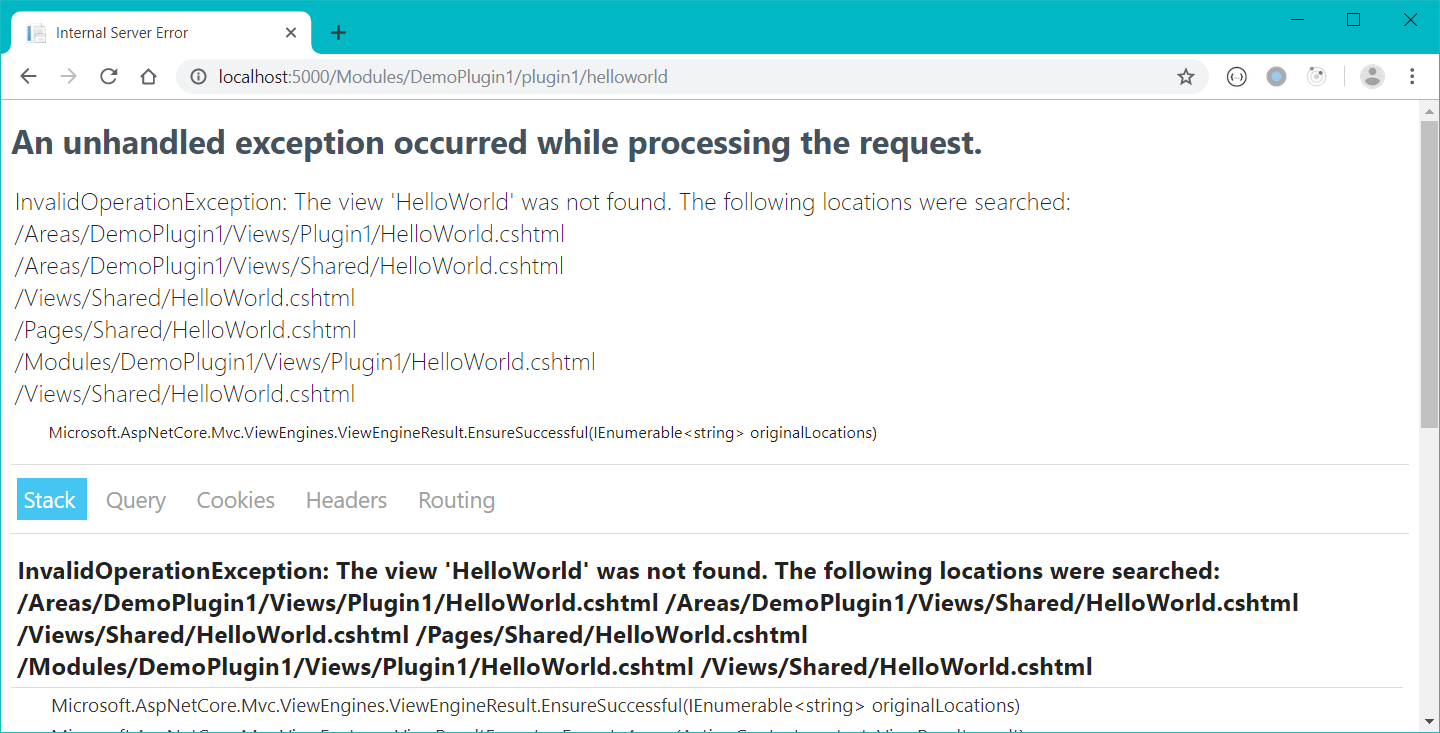

从零开始实现ASP.NET Core MVC的插件式开发(五) - 插件的删除和升级 - LamondLu
source link: https://www.cnblogs.com/lwqlun/p/11395828.html
Go to the source link to view the article. You can view the picture content, updated content and better typesetting reading experience. If the link is broken, please click the button below to view the snapshot at that time.
标题:从零开始实现ASP.NET Core MVC的插件式开发(五) - 使用AssemblyLoadContext实现插件的升级和删除
作者:Lamond Lu
地址:https://www.cnblogs.com/lwqlun/p/11395828.html
源代码:https://github.com/lamondlu/Mystique
在上一篇中,我为大家讲解了如何实现插件的安装,在文章的最后,留下了两个待解决的问题。
- .NET Core 2.2中不能实现运行时删除插件
- .NET Core 2.2中不能实现运行时升级插件
其实这2个问题归根结底其实都是一个问题,就是插件程序集被占用,不能在运行时更换程序集。在本篇中,我将分享一下我是如何一步一步解决这个问题的,其中也绕了不少弯路,查阅过资料,在.NET Core官方提过Bug,几次差点想放弃了,不过最终是找到一个可行的方案。
.NET Core 2.2的遗留问题
程序集被占用的原因#
回顾一下,我们之前加载插件程序集时所有使用的代码。
var provider = services.BuildServiceProvider();
using (var scope = provider.CreateScope())
{
var unitOfWork = scope.ServiceProvider.GetService<IUnitOfWork>();
var allEnabledPlugins = unitOfWork.PluginRepository
.GetAllEnabledPlugins();
foreach (var plugin in allEnabledPlugins)
{
var moduleName = plugin.Name;
var assembly = Assembly.LoadFile($"{AppDomain.CurrentDomain.BaseDirectory}Modules\\{moduleName}\\{moduleName}.dll");
var controllerAssemblyPart = new AssemblyPart(assembly);
mvcBuilders.PartManager
.ApplicationParts
.Add(controllerAssemblyPart);
}
}
这里我们使用了Assembly.LoadFile方法加载了插件程序集。 在.NET中使用Assembly.LoadFile方法加载的程序集会被自动锁定,不能执行任何转移,删除等造作,所以这就给我们删除和升级插件造成了很大困难。
PS: 升级插件需要覆盖已加载的插件程序集,由于程序集锁定,所以覆盖操作不能成功。
使用AssemblyLoadContext#
在.NET Framework中,如果遇到这个问题,常用的解决方案是使用AppDomain类来实现插件热插拔,但是在.NET Core中没有AppDomain类。不过经过查阅,.NET Core 2.0之后引入了一个AssemblyLoadContext类来替代.NET Freamwork中的AppDomain。本以为使用它就能解决当前程序集占用的问题,结果没想到.NET Core 2.x版本提供的AssemblyLoadContext没有提供Unload方法来释放加载的程序集,只有在.NET Core 3.0版本中才为AssemblyLoadContext类添加了Unload方法。
相关链接:
升级.NET Core 3.0 Preview 8
因此,为了完成插件的删除和升级功能,我将整个项目升级到了最新的.NET Core 3.0 Preview 8版本。
这里.NET Core 2.2升级到.NET Core 3.0有一点需要注意的问题。
在.NET Core 2.2中默认启用了Razor视图的运行时编译,简单点说就是.NET Core 2.2中自动启用了读取原始的Razor视图文件,并编译视图的功能。这就是我们在第三章和第四章中的实现方法,每个插件文件最终都放置在了一个Modules目录中,每个插件既有包含Controller/Action的程序集,又有对应的原始Razor视图目录Views,在.NET Core 2.2中当我们在运行时启用一个组件之后,对应的Views可以自动加载。
The files tree is:
=================
|__ DynamicPlugins.Core.dll
|__ DynamicPlugins.Core.pdb
|__ DynamicPluginsDemoSite.deps.json
|__ DynamicPluginsDemoSite.dll
|__ DynamicPluginsDemoSite.pdb
|__ DynamicPluginsDemoSite.runtimeconfig.dev.json
|__ DynamicPluginsDemoSite.runtimeconfig.json
|__ DynamicPluginsDemoSite.Views.dll
|__ DynamicPluginsDemoSite.Views.pdb
|__ Modules
|__ DemoPlugin1
|__ DemoPlugin1.dll
|__ Views
|__ Plugin1
|__ HelloWorld.cshtml
|__ _ViewStart.cshtml
但是在.NET Core 3.0中,Razor视图的运行时编译需要引入程序集Microsoft.AspNetCore.Mvc.Razor.RuntimeCompilation。并且在程序启动时,需要启动运行时编译的功能。
public void ConfigureServices(IServiceCollection services)
{
...
var mvcBuilders = services.AddMvc()
.AddRazorRuntimeCompilation();
...
}
如果没有启用Razor视图的运行时编译,程序访问插件视图的时候,就会报错,提示视图找不到。
使用.NET Core 3.0的AssemblyLoadContext加载程序集#
这里为了创建一个可回收的程序集加载上下文,我们首先基于AssemblyLoadcontext创建一个CollectibleAssemblyLoadContext类。其中我们将IsCollectible属性通过父类构造函数,将其设置为true。
public class CollectibleAssemblyLoadContext
: AssemblyLoadContext
{
public CollectibleAssemblyLoadContext()
: base(isCollectible: true)
{
}
protected override Assembly Load(AssemblyName name)
{
return null;
}
}
在整个插件加载上下文的设计上,每个插件都使用一个单独的CollectibleAssemblyLoadContext来加载,所有插件的CollectibleAssemblyLoadContext都放在一个PluginsLoadContext对象中。
相关代码: PluginsLoadContexts.cs
public static class PluginsLoadContexts
{
private static Dictionary<string, CollectibleAssemblyLoadContext>
_pluginContexts = null;
static PluginsLoadContexts()
{
_pluginContexts = new Dictionary<string, CollectibleAssemblyLoadContext>();
}
public static bool Any(string pluginName)
{
return _pluginContexts.ContainsKey(pluginName);
}
public static void RemovePluginContext(string pluginName)
{
if (_pluginContexts.ContainsKey(pluginName))
{
_pluginContexts[pluginName].Unload();
_pluginContexts.Remove(pluginName);
}
}
public static CollectibleAssemblyLoadContext GetContext(string pluginName)
{
return _pluginContexts[pluginName];
}
public static void AddPluginContext(string pluginName,
CollectibleAssemblyLoadContext context)
{
_pluginContexts.Add(pluginName, context);
}
}
代码解释:
- 当加载插件的时候,我们需要将当前插件的程序集加载上下文放到
_pluginContexts字典中。字典的key是插件的名称,字典的value是插件的程序集加载上下文。 - 当移除一个插件的时候,我们需要使用
Unload方法,来释放当前的程序集加载上下文。
在完成以上代码之后,我们更改程序启动和启用组件的代码,因为这两部分都需要将插件程序集加载到CollectibleAssemblyLoadContext中。
Startup.cs
var provider = services.BuildServiceProvider();
using (var scope = provider.CreateScope())
{
var option = scope.ServiceProvider
.GetService<MvcRazorRuntimeCompilationOptions>();
var unitOfWork = scope.ServiceProvider
.GetService<IUnitOfWork>();
var allEnabledPlugins = unitOfWork.PluginRepository
.GetAllEnabledPlugins();
foreach (var plugin in allEnabledPlugins)
{
var context = new CollectibleAssemblyLoadContext();
var moduleName = plugin.Name;
var filePath = $"{AppDomain.CurrentDomain.BaseDirectory}Modules\\{moduleName}\\{moduleName}.dll";
var assembly = context.LoadFromAssemblyPath(filePath);
var controllerAssemblyPart = new AssemblyPart(assembly);
mvcBuilders.PartManager.ApplicationParts
.Add(controllerAssemblyPart);
PluginsLoadContexts.AddPluginContext(plugin.Name, context);
}
}
PluginsController.cs
public IActionResult Enable(Guid id)
{
var module = _pluginManager.GetPlugin(id);
if (!PluginsLoadContexts.Any(module.Name))
{
var context = new CollectibleAssemblyLoadContext();
_pluginManager.EnablePlugin(id);
var moduleName = module.Name;
var filePath = $"{AppDomain.CurrentDomain.BaseDirectory}Modules\\{moduleName}\\{moduleName}.dll";
context.
var assembly = context.LoadFromAssemblyPath(filePath);
var controllerAssemblyPart = new AssemblyPart(assembly);
_partManager.ApplicationParts.Add(controllerAssemblyPart);
MyActionDescriptorChangeProvider.Instance.HasChanged = true;
MyActionDescriptorChangeProvider.Instance.TokenSource.Cancel();
PluginsLoadContexts.AddPluginContext(module.Name, context);
}
else
{
var context = PluginsLoadContexts.GetContext(module.Name);
var controllerAssemblyPart = new AssemblyPart(context.Assemblies.First());
_partManager.ApplicationParts.Add(controllerAssemblyPart);
_pluginManager.EnablePlugin(id);
MyActionDescriptorChangeProvider.Instance.HasChanged = true;
MyActionDescriptorChangeProvider.Instance.TokenSource.Cancel();
}
return RedirectToAction("Index");
}
意外结果#
完成以上代码之后,我立刻尝试了删除程序集的操作,但是得到的结果却不是我想要的。
虽然.NET Core 3.0为AssemblyLoadContext提供了Unload方法,但是调用之后, 你依然会得到一个文件被占用的错误
暂时不知道这是不是.NET Core 3.0的bug, 还是功能就是这么设计的,反正感觉这条路是走不通了,折腾了一天,在网上找了好多方案,但是都不能解决这个问题。
就在快放弃的时候,突然发现AssemblyLoadContext类提供了另外一种加载程序集的方式LoadFromStream。
改用LoadFromStream加载程序集#
看到LoadFromStream方法之后,我的第一思路就是可以使用FileStream加载插件程序集,然后将获得的文件流传给LoadFromStream方法,并在文件加载完毕之后,释放掉这个FileStream对象。
根据以上思路,我将加载程序集的方法修改如下
PS: Enable方法的修改方式类似,这里我就不重复写了。
var provider = services.BuildServiceProvider();
using (var scope = provider.CreateScope())
{
var option = scope.ServiceProvider
.GetService<MvcRazorRuntimeCompilationOptions>();
var unitOfWork = scope.ServiceProvider.GetService<IUnitOfWork>();
var allEnabledPlugins = unitOfWork.PluginRepository.GetAllEnabledPlugins();
foreach (var plugin in allEnabledPlugins)
{
var context = new CollectibleAssemblyLoadContext();
var moduleName = plugin.Name;
var filePath = $"{AppDomain.CurrentDomain.BaseDirectory}Modules\\{moduleName}\\{moduleName}.dll";
_presetReferencePaths.Add(filePath);
using (var fs = new FileStream(filePath, FileMode.Open))
{
var assembly = context.LoadFromStream(fs);
var controllerAssemblyPart = new AssemblyPart(assembly);
mvcBuilders.PartManager.ApplicationParts.Add(controllerAssemblyPart);
PluginsLoadContexts.AddPluginContext(plugin.Name, context);
}
}
}
修改之后,我又试了一下删除插件的代码,果然成功删除了。
"Empty path name is not legal. "问题#
就在我认为功能已经全部完成之后,我又重新安装了删除的插件,尝试访问插件中的controller/action, 结果得到了意想不到的错误,插件的中包含的页面打不开了。
fail: Microsoft.AspNetCore.Diagnostics.ExceptionHandlerMiddleware[1]
An unhandled exception has occurred while executing the request.
System.ArgumentException: Empty path name is not legal. (Parameter 'path')
at System.IO.FileStream..ctor(String path, FileMode mode, FileAccess access, FileShare share, Int32 bufferSize, FileOptions options)
at Microsoft.AspNetCore.Mvc.Razor.RuntimeCompilation.RazorReferenceManager.CreateMetadataReference(String path)
at System.Linq.Enumerable.SelectListIterator`2.ToList()
at System.Linq.Enumerable.ToList[TSource](IEnumerable`1 source)
at Microsoft.AspNetCore.Mvc.Razor.RuntimeCompilation.RazorReferenceManager.GetCompilationReferences()
at System.Threading.LazyInitializer.EnsureInitializedCore[T](T& target, Boolean& initialized, Object& syncLock, Func`1 valueFactory)
at System.Threading.LazyInitializer.EnsureInitialized[T](T& target, Boolean& initialized, Object& syncLock, Func`1 valueFactory)
at Microsoft.AspNetCore.Mvc.Razor.RuntimeCompilation.RazorReferenceManager.get_CompilationReferences()
at Microsoft.AspNetCore.Mvc.Razor.RuntimeCompilation.LazyMetadataReferenceFeature.get_References()
at Microsoft.CodeAnalysis.Razor.CompilationTagHelperFeature.GetDescriptors()
at Microsoft.AspNetCore.Razor.Language.DefaultRazorTagHelperBinderPhase.ExecuteCore(RazorCodeDocument codeDocument)
at Microsoft.AspNetCore.Razor.Language.RazorEnginePhaseBase.Execute(RazorCodeDocument codeDocument)
at Microsoft.AspNetCore.Razor.Language.DefaultRazorEngine.Process(RazorCodeDocument document)
at Microsoft.AspNetCore.Razor.Language.DefaultRazorProjectEngine.ProcessCore(RazorCodeDocument codeDocument)
at Microsoft.AspNetCore.Razor.Language.RazorProjectEngine.Process(RazorProjectItem projectItem)
at Microsoft.AspNetCore.Mvc.Razor.RuntimeCompilation.RuntimeViewCompiler.CompileAndEmit(String relativePath)
at Microsoft.AspNetCore.Mvc.Razor.RuntimeCompilation.RuntimeViewCompiler.OnCacheMiss(String normalizedPath)
--- End of stack trace from previous location where exception was thrown ---
at Microsoft.AspNetCore.Mvc.Razor.Compilation.DefaultRazorPageFactoryProvider.CreateFactory(String relativePath)
at Microsoft.AspNetCore.Mvc.Razor.RazorViewEngine.CreateCacheResult(HashSet`1 expirationTokens, String relativePath, Boolean isMainPage)
at Microsoft.AspNetCore.Mvc.Razor.RazorViewEngine.OnCacheMiss(ViewLocationExpanderContext expanderContext, ViewLocationCacheKey cacheKey)
at Microsoft.AspNetCore.Mvc.Razor.RazorViewEngine.LocatePageFromViewLocations(ActionContext actionContext, String pageName, Boolean isMainPage)
at Microsoft.AspNetCore.Mvc.Razor.RazorViewEngine.FindView(ActionContext context, String viewName, Boolean isMainPage)
at Microsoft.AspNetCore.Mvc.ViewEngines.CompositeViewEngine.FindView(ActionContext context, String viewName, Boolean isMainPage)
at Microsoft.AspNetCore.Mvc.ViewFeatures.ViewResultExecutor.FindView(ActionContext actionContext, ViewResult viewResult)
at Microsoft.AspNetCore.Mvc.ViewFeatures.ViewResultExecutor.ExecuteAsync(ActionContext context, ViewResult result)
at Microsoft.AspNetCore.Mvc.ViewResult.ExecuteResultAsync(ActionContext context)
at Microsoft.AspNetCore.Mvc.Infrastructure.ResourceInvoker.<InvokeNextResultFilterAsync>g__Awaited|29_0[TFilter,TFilterAsync](ResourceInvoker invoker, Task lastTask, State next, Scope scope, Object state, Boolean isCompleted)
at Microsoft.AspNetCore.Mvc.Infrastructure.ResourceInvoker.Rethrow(ResultExecutedContextSealed context)
at Microsoft.AspNetCore.Mvc.Infrastructure.ResourceInvoker.ResultNext[TFilter,TFilterAsync](State& next, Scope& scope, Object& state, Boolean& isCompleted)
at Microsoft.AspNetCore.Mvc.Infrastructure.ResourceInvoker.InvokeResultFilters()
--- End of stack trace from previous location where exception was thrown ---
at Microsoft.AspNetCore.Mvc.Infrastructure.ResourceInvoker.<InvokeNextResourceFilter>g__Awaited|24_0(ResourceInvoker invoker, Task lastTask, State next, Scope scope, Object state, Boolean isCompleted)
at Microsoft.AspNetCore.Mvc.Infrastructure.ResourceInvoker.Rethrow(ResourceExecutedContextSealed context)
at Microsoft.AspNetCore.Mvc.Infrastructure.ResourceInvoker.Next(State& next, Scope& scope, Object& state, Boolean& isCompleted)
at Microsoft.AspNetCore.Mvc.Infrastructure.ResourceInvoker.InvokeFilterPipelineAsync()
--- End of stack trace from previous location where exception was thrown ---
at Microsoft.AspNetCore.Mvc.Infrastructure.ResourceInvoker.<InvokeAsync>g__Awaited|17_0(ResourceInvoker invoker, Task task, IDisposable scope)
at Microsoft.AspNetCore.Routing.EndpointMiddleware.<Invoke>g__AwaitRequestTask|6_0(Endpoint endpoint, Task requestTask, ILogger logger)
at Microsoft.AspNetCore.Routing.EndpointRoutingMiddleware.SetRoutingAndContinue(HttpContext httpContext)
at Microsoft.AspNetCore.Diagnostics.ExceptionHandlerMiddleware.<Invoke>g__Awaited|6_0(ExceptionHandlerMiddleware middleware, HttpContext context, Task task)
这个文件路径非法的错误让我感觉很奇怪,为什么会有这种问题呢?与之前的代码的不同之处只有一个地方,就是从LoadFromAssemblyPath改为了LoadFromStream。
为了弄清这个问题,我clone了最新的.NET Core 3.0 Preview 8源代码,发现了在 .NET Core运行时编译视图的时候,会调用如下方法。
RazorReferenceManager.cs
internal IEnumerable<string> GetReferencePaths()
{
var referencePaths = new List<string>();
foreach (var part in _partManager.ApplicationParts)
{
if (part is ICompilationReferencesProvider compilationReferenceProvider)
{
referencePaths.AddRange(compilationReferenceProvider.GetReferencePaths());
}
else if (part is AssemblyPart assemblyPart)
{
referencePaths.AddRange(assemblyPart.GetReferencePaths());
}
}
referencePaths.AddRange(_options.AdditionalReferencePaths);
return referencePaths;
}
这段代码意思是根据当前加载程序集的所在位置,来发现对应视图。
那么问题就显而易见了,我们之前用LoadFromAssemblyPath加载程序集,程序集的文件位置被自动记录下来,但是我们改用LoadFromStream之后,所需的文件位置信息丢失了,是一个空字符串,所以.NET Core在尝试加载视图的时候,遇到空字符串,抛出了一个非法路径的错误。
其实这里的方法很好改,只需要将空字符串的路径排除掉即可。
internal IEnumerable<string> GetReferencePaths()
{
var referencePaths = new List<string>();
foreach (var part in _partManager.ApplicationParts)
{
if (part is ICompilationReferencesProvider compilationReferenceProvider)
{
referencePaths.AddRange(compilationReferenceProvider.GetReferencePaths());
}
else if (part is AssemblyPart assemblyPart)
{
referencePaths.AddRange(assemblyPart.GetReferencePaths().Where(o => !string.IsNullOrEmpty(o));
}
}
referencePaths.AddRange(_options.AdditionalReferencePaths);
return referencePaths;
}
但是由于不清楚会不会导致其他问题,所以我没有采取这种方法,我将这个问题作为一个Bug提交到了官方。
没想到仅仅8小时,就得到官方的解决方案。
这段意思是说ASP.NET Core暂时不支持动态加载程序集,如果要在当前版本实现功能,需要自己实现一个AssemblyPart类, 在获取程序集路径的时候,返回空集合而不是空字符串。
PS: 官方已经将这个问题放到了.NET 5 Preview 1中,相信.NET 5中会得到真正的解决。
根据官方的方案,Startup.cs文件的最终版本
public class MyAssemblyPart : AssemblyPart, ICompilationReferencesProvider
{
public MyAssemblyPart(Assembly assembly) : base(assembly) { }
public IEnumerable<string> GetReferencePaths() => Array.Empty<string>();
}
public static class AdditionalReferencePathHolder
{
public static IList<string> AdditionalReferencePaths = new List<string>();
}
public class Startup
{
public IList<string> _presets = new List<string>();
public Startup(IConfiguration configuration)
{
Configuration = configuration;
}
public IConfiguration Configuration { get; }
// This method gets called by the runtime. Use this method to add services to the container.
public void ConfigureServices(IServiceCollection services)
{
services.AddOptions();
services.Configure<ConnectionStringSetting>(Configuration.GetSection("ConnectionStringSetting"));
services.AddScoped<IPluginManager, PluginManager>();
services.AddScoped<IUnitOfWork, UnitOfWork>();
var mvcBuilders = services.AddMvc()
.AddRazorRuntimeCompilation(o =>
{
foreach (var item in _presets)
{
o.AdditionalReferencePaths.Add(item);
}
AdditionalReferencePathHolder.AdditionalReferencePaths = o.AdditionalReferencePaths;
});
services.Configure<RazorViewEngineOptions>(o =>
{
o.AreaViewLocationFormats.Add("/Modules/{2}/Views/{1}/{0}" + RazorViewEngine.ViewExtension);
o.AreaViewLocationFormats.Add("/Views/Shared/{0}.cshtml");
});
services.AddSingleton<IActionDescriptorChangeProvider>(MyActionDescriptorChangeProvider.Instance);
services.AddSingleton(MyActionDescriptorChangeProvider.Instance);
var provider = services.BuildServiceProvider();
using (var scope = provider.CreateScope())
{
var option = scope.ServiceProvider.GetService<MvcRazorRuntimeCompilationOptions>();
var unitOfWork = scope.ServiceProvider.GetService<IUnitOfWork>();
var allEnabledPlugins = unitOfWork.PluginRepository.GetAllEnabledPlugins();
foreach (var plugin in allEnabledPlugins)
{
var context = new CollectibleAssemblyLoadContext();
var moduleName = plugin.Name;
var filePath = $"{AppDomain.CurrentDomain.BaseDirectory}Modules\\{moduleName}\\{moduleName}.dll";
_presets.Add(filePath);
using (var fs = new FileStream(filePath, FileMode.Open))
{
var assembly = context.LoadFromStream(fs);
var controllerAssemblyPart = new MyAssemblyPart(assembly);
mvcBuilders.PartManager.ApplicationParts.Add(controllerAssemblyPart);
PluginsLoadContexts.AddPluginContext(plugin.Name, context);
}
}
}
}
public void Configure(IApplicationBuilder app, IWebHostEnvironment env)
{
if (env.IsDevelopment())
{
app.UseDeveloperExceptionPage();
}
else
{
app.UseExceptionHandler("/Home/Error");
}
app.UseStaticFiles();
app.UseRouting();
app.UseEndpoints(routes =>
{
routes.MapControllerRoute(
name: "Customer",
pattern: "{controller=Home}/{action=Index}/{id?}");
routes.MapControllerRoute(
name: "Customer",
pattern: "Modules/{area}/{controller=Home}/{action=Index}/{id?}");
});
}
}
插件删除和升级的代码
解决了程序集占用问题之后,我们就可以开始编写删除/升级插件的代码了。
删除插件#
如果要删除一个插件,我们需要完成以下几个步骤
- 删除组件记录
- 删除组件迁移的表结构
- 移除加载过的ApplicationPart
- 刷新Controller/Action
- 移除组件对应的程序集加载上下文
- 删除组件文件
根据这个步骤,我编写了一个Delete方法,代码如下:
public IActionResult Delete(Guid id)
{
var module = _pluginManager.GetPlugin(id);
_pluginManager.DisablePlugin(id);
_pluginManager.DeletePlugin(id);
var moduleName = module.Name;
var matchedItem = _partManager.ApplicationParts.FirstOrDefault(p =>
p.Name == moduleName);
if (matchedItem != null)
{
_partManager.ApplicationParts.Remove(matchedItem);
matchedItem = null;
}
MyActionDescriptorChangeProvider.Instance.HasChanged = true;
MyActionDescriptorChangeProvider.Instance.TokenSource.Cancel();
PluginsLoadContexts.RemovePluginContext(module.Name);
var directory = new DirectoryInfo($"{AppDomain.CurrentDomain.BaseDirectory}Modules/{module.Name}");
directory.Delete(true);
return RedirectToAction("Index");
}
升级插件#
对于升级插件的代码,我将它和新增插件的代码放在了一起
public void AddPlugins(PluginPackage pluginPackage)
{
var existedPlugin = _unitOfWork.PluginRepository.GetPlugin(pluginPackage.Configuration.Name);
if (existedPlugin == null)
{
InitializePlugin(pluginPackage);
}
else if (new DomainModel.Version(pluginPackage.Configuration.Version) > new DomainModel.Version(existedPlugin.Version))
{
UpgradePlugin(pluginPackage, existedPlugin);
}
else
{
DegradePlugin(pluginPackage);
}
}
private void InitializePlugin(PluginPackage pluginPackage)
{
var plugin = new DTOs.AddPluginDTO
{
Name = pluginPackage.Configuration.Name,
DisplayName = pluginPackage.Configuration.DisplayName,
PluginId = Guid.NewGuid(),
UniqueKey = pluginPackage.Configuration.UniqueKey,
Version = pluginPackage.Configuration.Version
};
_unitOfWork.PluginRepository.AddPlugin(plugin);
_unitOfWork.Commit();
var versions = pluginPackage.GetAllMigrations(_connectionString);
foreach (var version in versions)
{
version.MigrationUp(plugin.PluginId);
}
pluginPackage.SetupFolder();
}
public void UpgradePlugin(PluginPackage pluginPackage, PluginViewModel oldPlugin)
{
_unitOfWork.PluginRepository.UpdatePluginVersion(oldPlugin.PluginId,
pluginPackage.Configuration.Version);
_unitOfWork.Commit();
var migrations = pluginPackage.GetAllMigrations(_connectionString);
var pendingMigrations = migrations.Where(p => p.Version > oldPlugin.Version);
foreach (var migration in pendingMigrations)
{
migration.MigrationUp(oldPlugin.PluginId);
}
pluginPackage.SetupFolder();
}
public void DegradePlugin(PluginPackage pluginPackage)
{
throw new NotImplementedException();
}
代码解释:
-
这里我首先判断了当前插件包和已安装版本的版本差异
- 如果系统没有安装过当前插件,就安装插件
- 如果当前插件包的版本比已安装的版本高,就升级插件
- 如果当前插件包的版本比已安装的版本低,就降级插件(现实中这种情况不多)
-
InitializePlugin是用来加载新组件的,它的内容就是之前的新增插件方法 -
UpgradePlugin是用来升级组件的,当我们升级一个组件的时候,我们需要做一下几个事情- 升级组件版本
- 做最新版本组件的脚本迁移
- 使用最新程序包覆盖老程序包
-
DegradePlugin是用来降级组件的,由于篇幅问题,我就不详细写了,大家可以自行填补。
本篇中,我为大家演示如果使用.NET Core 3.0的AssemblyLoadContext来解决已加载程序集占用的问题,以此实现了插件的升级和降级。本篇的研究时间较长,因为中间出现的问题确实太多了,没有什么可以复用的方案,我也不知道是不是第一个在.NET Core中这么尝试的。不过结果还算好,想实现的功能最终还是做出来了。后续呢,这个项目会继续添加新的功能,希望大家多多支持。
Recommend
About Joyk
Aggregate valuable and interesting links.
Joyk means Joy of geeK

